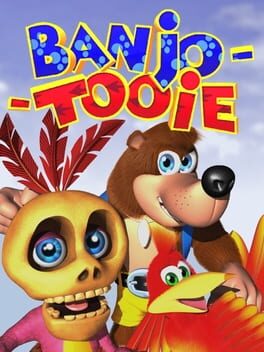Consider me pleasantly surprised! Everything I'd heard about this game prior was that it was an iterative sequel with worse level design, and I guess that is true if you approach it exactly like you did with Banjo-Oneie. But these levels aren't meant to be compact, easily sight-read, or fully completed in a single sitting. Try to do so and you'll only end up frustrated, because Tooie is really closer to a 3D Zelda game than a collectathon. Worlds are laid out more like Kakariko Village than Treasure Trove Cove, with a few obvious points of interests in each that conceal lengthy, labyrinthine subareas. Oneie essentially guaranteed that any major task would reward you with a major collectible, while Tooie leaves it more up in the air. Being used to the first game, I assumed beating the timer challenge in Glitter Gulch Mine would earn me a jiggy, so I left it for when I ran out of anything else to do, but it actually unlocks a long series of rooms that significantly increases the scope of the level. Shifting this precedent means there's genuine anticipation as to what you're going to find whenever you make progress, and once you realize the game's designed around masking secrets and hidden areas with occasionally difficult to internalize architecture, a lot of baffling-at-first decisions make complete sense. Why do you need a certain number of notes to learn new moves this time? Well, it's not about actually making players earn upgrades, considering I was always well beyond each respective note threshold, but rather creating an association between notes and Jamjars. The first thing you want to do whenever entering a new world is find its new moves, because they're never gated behind moves from later levels, and are theoretically more valuable than any item. Tooie takes this mindset and uses it to give players a guided preliminary tour of the location, strategically placing Jamjars's bunkers in major areas that might not have been apparent at first. There's less notes in every level because they're generally only used to signify Jamjars's presence- whenever you see some, he's probably nearby. The first trip to every world consists of finding new moves by way of finding notes, which has the intended side effect of giving the player enough information to begin to sketch a mental map. Of course, you can only complete a fraction of every level on your first go-round, so you'll probably poke around just a bit and grab a few Jinjos before calling it quits and returning to a previous world to flesh out one of your earlier pieces of Jamjars-assisted layout knowledge. And these revisits, layered several times for every area throughout the game, are where Tooie's unique blend of collectathoning and progression gates separates itself most from other adventure game subgenres. In a search-action game, you have to evaluate whether or not you have enough upgrades to make it to an out of reach area. In a point-and-click, you have to think about what kind of contextual event will allow you to get where you want to go. In a Zelda game, you have to consider both, but Link's lack of mobility doesn't obfuscate the seams between these two factors as much as it would if he was in, say, a platformer. That's not to imply that the puzzles in here are ever particularly great on their own merits, but it's still fun to feel out what exactly you can and can't do before eventually putting everything together. Though, it seems that's where Tooie loses a lot of people. My favorite parts of Zelda games are when you're wandering around without any idea of how to progress, so maybe I just have an immunity to it, but is the backtracking really that bad? I'd assumed early on that the in-level teleporters were a QoL change added in the Xbox version, because fast travel in this game feels... pretty generous! That being said, I didn't come close to 100%ing this game, and I probably would've liked it less if I did. While Oneie's worlds felt appropriately shallow so as to not detract from the joy of fully completing them, Tooie's come chock-full of surprises, and, as a result, it's more fun to skirt by with just as many jiggies as you need to unlock the next level. In my eyes, Oneie fills its niche as an easygoing collectathon better than Tooie fills its niche as a 3D adventure game, but I'd still argue that it's a great sequel. And even when it falters, and, boy does it falter- I haven't mentioned the over reliance on minigames, or the mostly pointless transformations, or the entirely pointless parts where you play as Mumbo- there's enough raw fifth-gen ambition to keep things interesting throughout.
2 Comments
True honestly

Kaibacorporate
8 months ago